
Types of Opals: A Comprehensive List of Opal Types, Origins, Colors & More!
 Opals look like they hold galaxies, but did you know there’s a world of opal types available? Mostly known as the October birthstone, opals are fascinating miracles of nature and come in numerous varieties!
Opals look like they hold galaxies, but did you know there’s a world of opal types available? Mostly known as the October birthstone, opals are fascinating miracles of nature and come in numerous varieties!
When it comes to opal types and meanings, opals generally symbolize hope and innocence, but an opal’s meaning can differ based on the opal type.
So, what types of opals are there?
Today, we’ll cover all types of opals with pictures separated by category, origin, and color. Before we start, let’s break down how to classify opals.
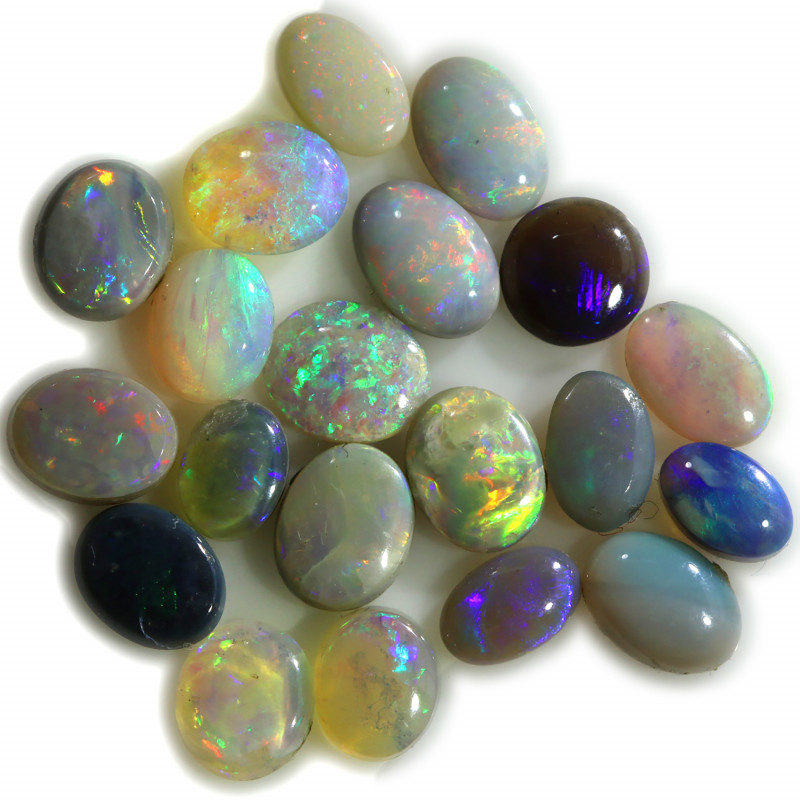
What Are Opal Types?
Hundreds of opal types exist around the world, but the first distinction to know is common versus precious opals. Precious opals display iridescent play-of-color, while common opals do not.
The primary method for classifying opals is by body color. The technical term is body tone, though “base tone” or “background color” are also used.
In precious opals, body tone is the relative darkness or lightness of the stone’s background. Body tone in common opals is simply based on the stone’s overall color.
Other groupings include the opal’s source, inclusions, and formation. Before we get into those, what are 3 different types of opals most people shop for?
Most Popular Opal Types
Despite the abundance of different opal varieties, three opal types take the lead: white/light opal, gray/dark opal, and black opal.

White/Light Opal
Light or white opal refers to any opal with an N7-N9 body tone and can be common or precious. Light opals range from colorless to light gray, while white opals have a white to pale gray body. These opals can be transparent to semi-opaque, but most have a milky tone.
White is the most common opal color and most abundant precious opal type. Australia’s Coober Pedy mine has earned the moniker “opal capital of the world” for its abundance of white precious opals.

Gray/Dark Opal
Gray or dark opal is between white and black, at N5-N6 body tones. Also called “semi-black opals,” these common or precious opals have a medium gray body tone that isn’t dark enough to be black opal. The majority of dark opal comes from Lightning Ridge or Mintabie, Australia. This type is less common than white opal but shows a brighter play-of-color.
Speaking of dark opals, what is the rarest opal type?
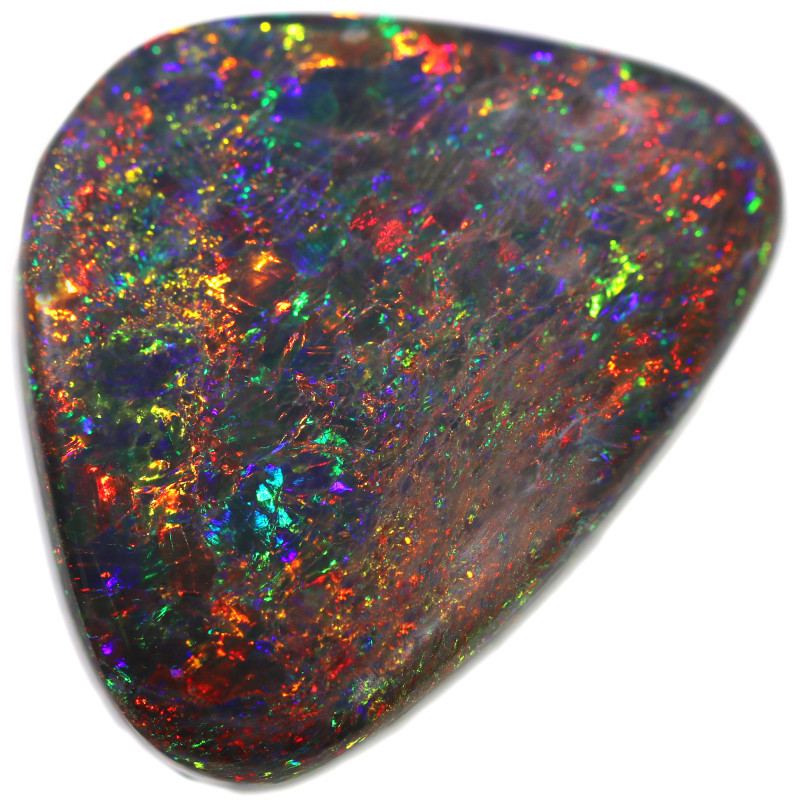
Black Opal
Black opal is the rarest opal variety, defined by a dark gray to black body tone from N1-N4. These opals can be transparent black crystal opals or opaque, though both common and precious black opals are available.
While rare, most gem-quality black opals come from Lightning Ridge, Australia. Black precious opal has the brightest play-of-color of any opal. What other colors do opals come in?
Opals By Body Color
Beyond white, gray, and black, you can also find opals in pink, purple (morado), blue, green, colorless, and fire hues. Let’s explore each one!

Pink Opal
Pink opal is a common opal in pale to bubblegum pink, though other colors like white, yellow, peach, lavender, and black may appear as well. This opal type commonly has inclusions that create dark streaking or color zones.
Pink opals come from Australia, Mexico, and the USA, but Peru is the most prolific source. Peruvian pink opals have a milky tone and vivid, uniform color, particularly “pink Andean opal.”
Western Australia’s pink opals are actually opalized radiolarite and often heavily included (meaning they have trace quantities of other minerals or debris), creating white, brown, or black patterns.
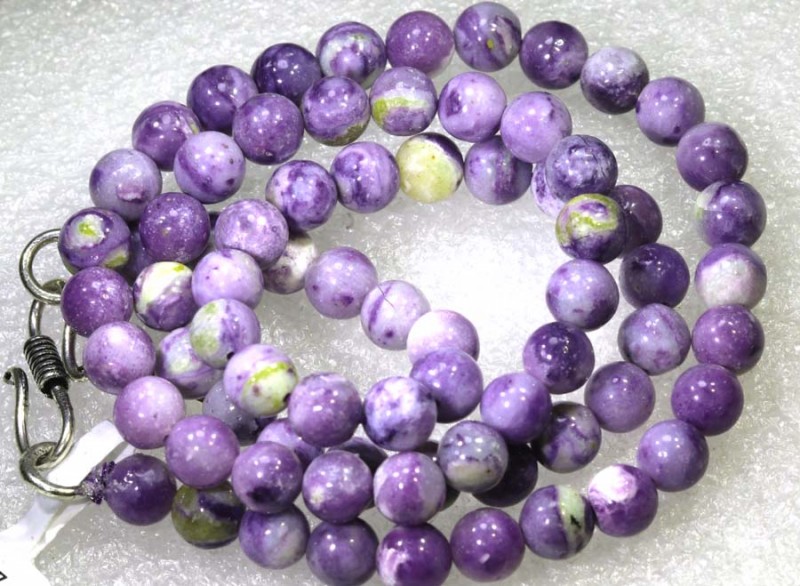
Morado Opal
Morado opal, also called “purple opal” or “Opal Royale,” is a purple common opal variety native to Mexico. The colors range from lavender to violet, and are typically milky and opaque in tone. Purple hues also appear in Tiffany opal, an opal fluorite conglomerate from Utah, USA, colored purple by fluorine gasses.

Blue Opals
Blue opals can be common or precious, ranging from deep teal to pale sky-blue. Peru is largely tied to this variety, and “blue opal” often refers to Peruvian common blue opal. Peru also produces precious blue opal, and some stones have play-of-color in small zones.
Brazil joins Peru in producing a rare blue-green opal called Paraiba opal. Other blue opal mines are in Slovakia, Indonesia, and the USA, including Oregon’s pastel blue Owyhee opals.
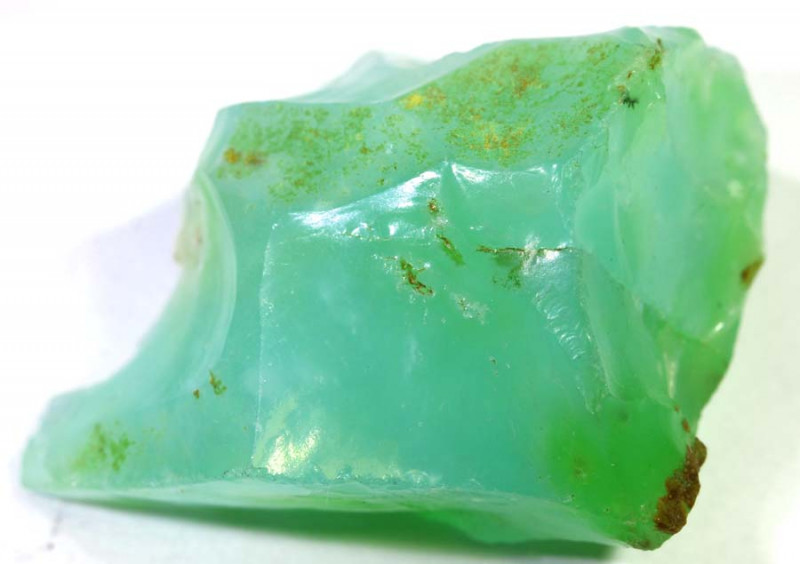
Green Opals
One common opal found worldwide is green opal, seen in striking shades of emerald, yellow-green, or muted jade. Found in six continents, the most prominent mines are in Australia, Brazil, Peru, Mexico, and the USA.
Natural opalite is another green common opal variety, though it also shows shades of purple. Opalite is typically mossy-green with dark dendritic inclusions and can show chatoyancy (the cat’s eye effect.) Most specimens come from Africa, but Ethiopia’s cat’s eye opalite is often honey or yellow.
One more type of green opal is Tanzanian prase opal. This variety contains nickel, which gives the stone a glowing neon teal color. Prase opals are translucent to transparent, and some call them “African jade.”
Next up, what color opal is most valuable? That would be red opal, which also happens to be the most valuable color of fire opal.
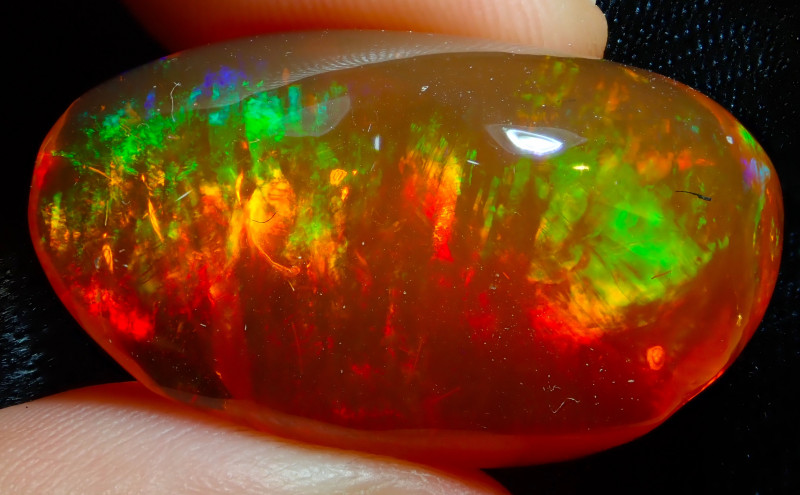
Fire Opal
Do you love a fiery spectacle? You’ll find precisely that in fire opals. Fire opals come in red, orange, yellow, and brown body colors and can be either common or precious. Originating in Mexico, these stones are often called Mexican fire opals, though they also come from Australia and Ethiopia.
Fire opals differ from most opals in being translucent to transparent (not opaque) and forming inside volcanoes. Most Mexican fire opals are common opals, but Ethiopia produces precious fire opals with neon violet and green color flashes.
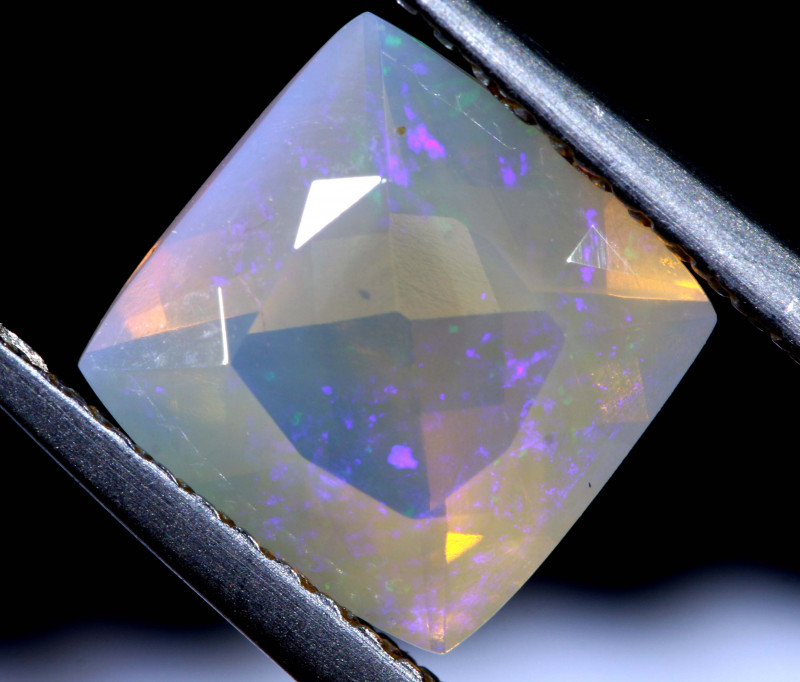
Colorless Opal
Outside the rainbow, we have colorless opal types. While they may lack color seen in the opals mentioned above, they each offer unique properties.
Crystal Opal: Any precious opal that is colorless and transparent, with no milkiness and N7-N8 on the body tone scale.
Jelly Opal/Water Opal: Transparent, colorless precious opals that are slightly darker than crystal opals and have a gelatinous appearance, sometimes with an internal play-of-color and blue or golden sheen.
Contraluz Opal: Translated from Spanish as “against light,” colorless precious opals show play-of-color floating inside the opal when you illuminate the stone from the back.
Moving into the next category, we have opal types defined by forming with other materials.
Opal Inclusions & Varieties
Most opals form by similar processes, but when an opal interacts with nearby minerals and particles during formation, it can create an entirely new opal type. The opal and other materials may merge externally, with the opal growing around another mineral, or internally, with inclusions getting trapped inside the opal.
Inclusions encompass any material trapped in a gemstone while the stone formed. While most surface-level materials on a stone are called “blemishes,” internal inclusions can sometimes reach the surface.
If you’re wondering what kind of opal is best, many would say the first mineral-combo opal variety on our list: boulder opal!

Boulder Opal
Boulder opal is a combination of precious opal and host rock, typically ironstone or sandstone, though some contain vegetation or fossilized wood instead of rock.
The precious opal occurs as patches and/or thin seams attached or surrounded by the host rock. This happens when pre-formed opal silica water seeps into the rock’s crevices before the opal hardens.
The first source of boulder opal was Queensland, Australia, and this locale remains a prolific source. Other boulder opal locations include Brazil and Canada.
Boulder opals have a few subtypes:
Boulder Opal Wood Fossil: Also called fossil wood replacement opal, this variety contains opalized wood attached to the host rock.
Andamooka Boulder Opal: Mined in Andamooka, Australia, these rare opals have quartzite host rocks and are sometimes called “painted ladies.”
Opal Nut: Found in Australia’s Yowah or Koroit opal fields, opal nuts are rounded boulder opals resembling a tree nut and have distinct banding. Boulder opals from these fields typically have chocolate brown ironstone backing, while other mines produce stones with light brown backings.
Boulder Pipe Crystal Opal: This variety contains crystal opal formed inside hollow or tubular cylinders within the host rock.
Cantera Opal: This type is composed of fire opal or precious opal in pink rhyolite.
Boulder opals can also come as boulder matrix opals, a subtype that mixes with our next variety: matrix opal!
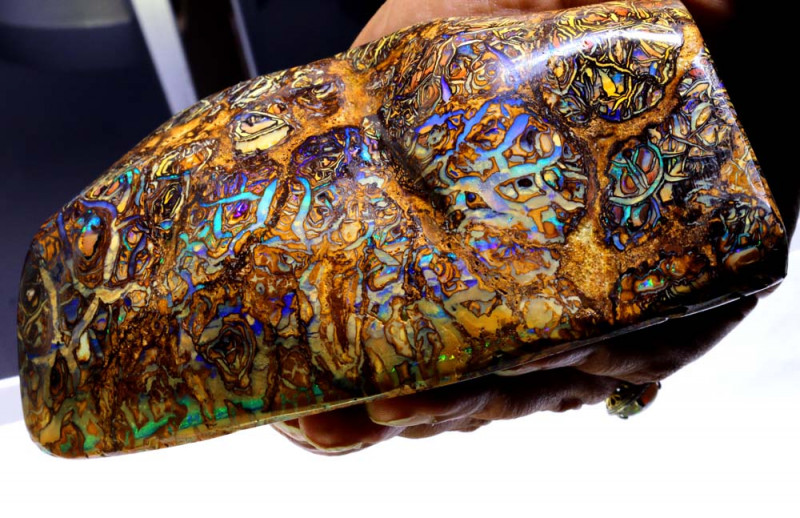
Matrix Opal
Like boulder opal, matrix opal contains precious opal combined with its host rock. In matrix opal, however, the precious opal fills holes or pores between the host rock’s grains, creating a more even play-of-color throughout the stone instead of in distinct sections.
Matrix opal comes from Mexico, Honduras, and Australia. In Australia, Andamooka matrix opal is porous, so it’s easily (and often) chemically treated to improve its color. Honduras produces primarily matrix opal and their opaque variety typically has a dark host rock speckled with vibrant opal.
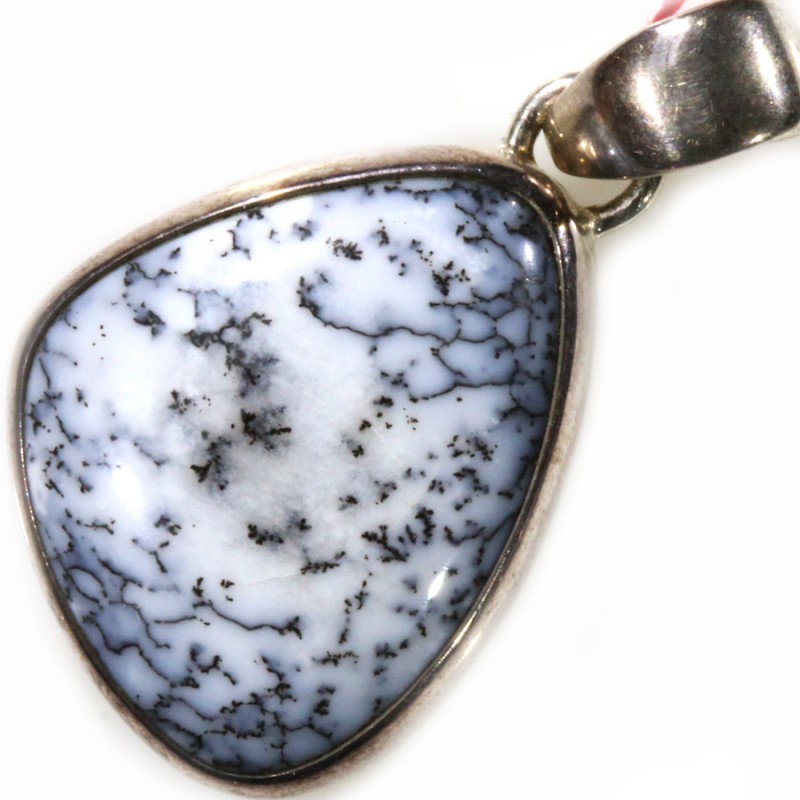
Dendritic Opal
Also called “moss opal,” dendritic opal is a white or yellow-brown type of common opal characterized by green or brown moss-like (dendritic) inclusions. These inclusions, often manganese or iron, form unique patterns, including those reminiscent of a forest landscape seen in “landscape opals.”
Dendritic opals can be nearly 30 percent water, which classifies them as “soft gems.” Most of these opals come from Australia, Mexico, or the USA, but you can also find them throughout Central America, Asia, and Russia.
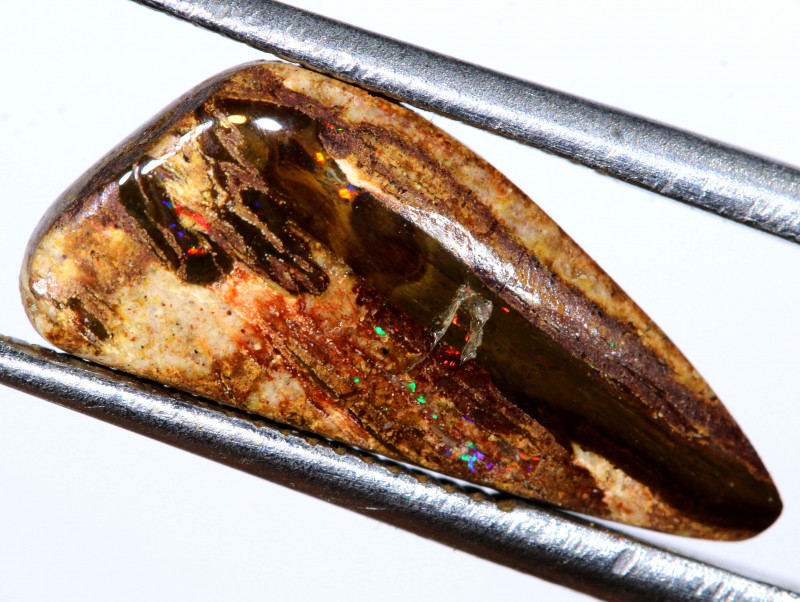
Opalized Wood
Opalized wood is a type of petrified wood containing opal. Petrified wood is fossilized timber or vegetation where part of the plant has been replaced by stone, in this case, opal!
These earthly beauties form when silica water preserves buried wood tissues. Where does this natural phenomenon happen? Opalized wood commonly forms in forests covered in ashfall. Prominent deposits are in the USA, Indonesia, Russia, Mexico, and Brazil.
Moving from combinations formed naturally, let’s look next at how humans combine opals with other materials.
Composite Opals
Most opals are solids, composed of 100% opal. Natural opals mixed with non-opal materials, for example, aren’t opal solids. However, the more salient distinction is between solid and composite opals. Composite or “assembled” opals have been modified by jewelers and include doublet, triplet, and mosaic/chip opals. Why tweak such a naturally flawless specimen? Composite opals offer affordable prices to consumers, making them a great alternative to genuine opals.
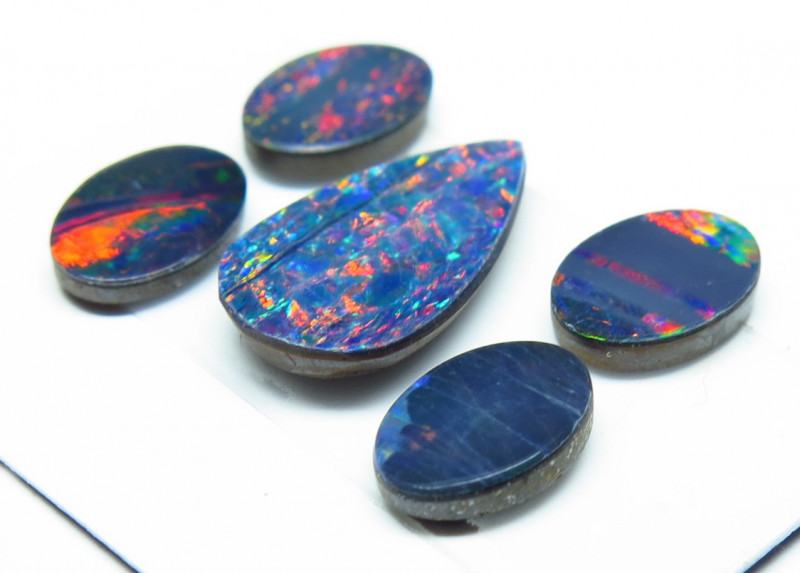
Doublet Opals
Doublet opals are composite opals with a thin slice of precious opal glued to a base layer. The base may be ironstone to emulate boulder opal, another mineral, or plastic. Often, precious light opal is glued to a black base to resemble precious black opal.
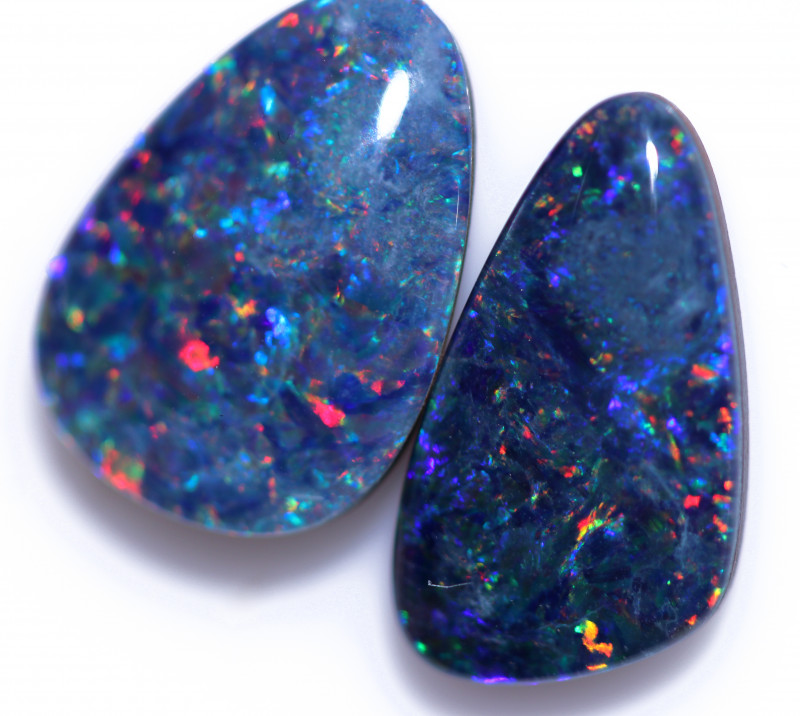
Triplet Opals
Opal triplets are essentially doublets with a protective crystal dome glued on top. The dome may be glass, quartz, or plastic and also magnifies the stone’s color play. Triplets are generally less expensive than doublets because less opal is used.

Mosaic & Chip Opals
Mosaic and chip opals are two composite opals where pieces of opal are put back together into a new form. With mosaic opals, small pieces that are flat or oddly shaped get glued like stained glass onto a dark base. For chip opals, the opal pieces are mixed with resin and contained to harden into the desired shape.
Before jewelers can assemble composite opals, miners have to find the stones. Being that there are so many opal types, where are opals found in the world?
Geological factors and terrain, which vastly vary from region to region, are the most significant influences on an opal’s type. The ground, atmosphere, and minerals that shape an opal vary across the globe, so let’s go on a world tour!
Opals By Source
Every opal mine worldwide tends to specialize in a specific opal type. Come along as we travel the world’s opal mines to learn their specialties!
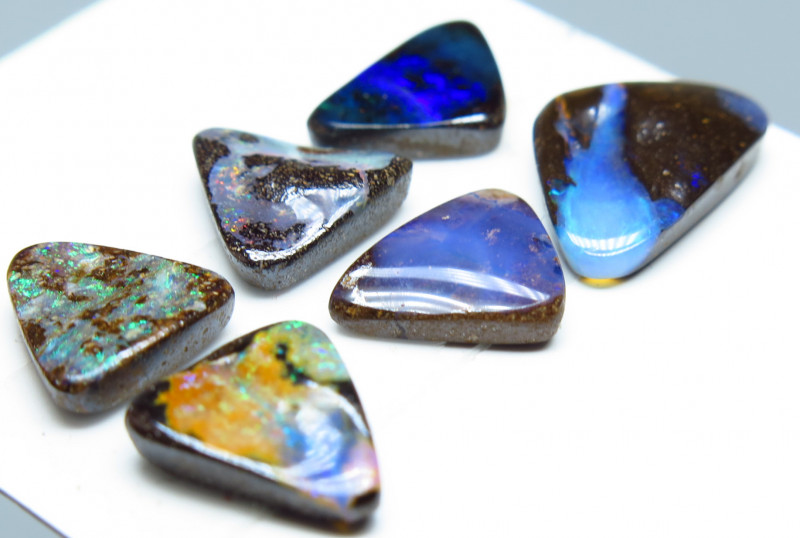
Australian Opals
It’s no secret that Australia is the world’s largest supplier of opals. That’s because Australia has a number of significant mining fields, each known for different types of Australian opal:
Andamooka: Known for bright crystal seam opal.
Coober Pedy: Main producer of white opal.
Lightning Ridge: Largest opal producer by value and known for high-quality black opals.
Queensland: Contains Koroit and Yowah opal fields and mines that supply nearly all of the world’s boulder opals.
Tintenbar: Produces volcanic dark jelly opal.
White Cliffs Opal: Known for white and precious seam opal, along with opalized pineapple fossils.
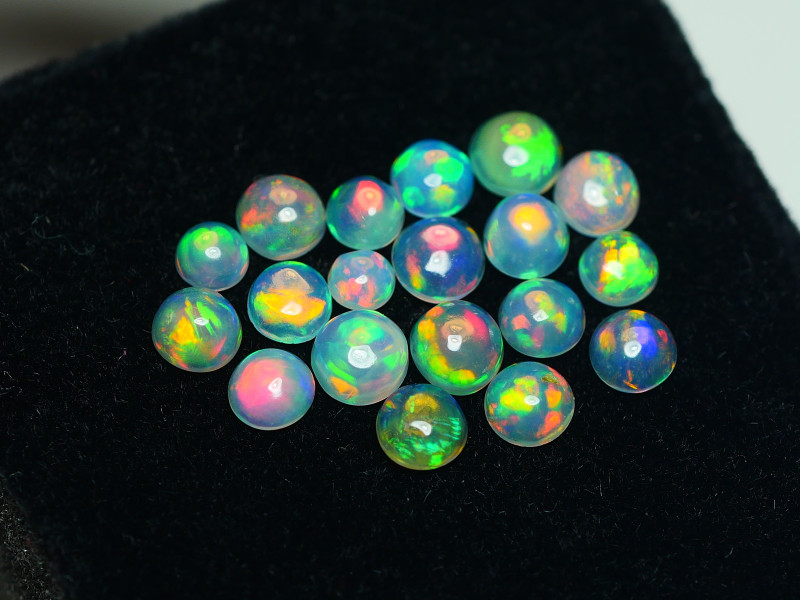
African Opals
In recent decades the discovery of several opal deposits in Ethiopia has landed Africa as an important source on the opal map.
Ethiopian Opal: Known for hydrophane opals with vivid play-of-color and precious black or white opals.
Tanzanian Opal: Produces the most prase opal.
Madagascar Opal: Recently discovered pyrophane opals and Girasol fire opals.
Kenyan Opal: Known for oldest opal remnants and olive-green common opals.
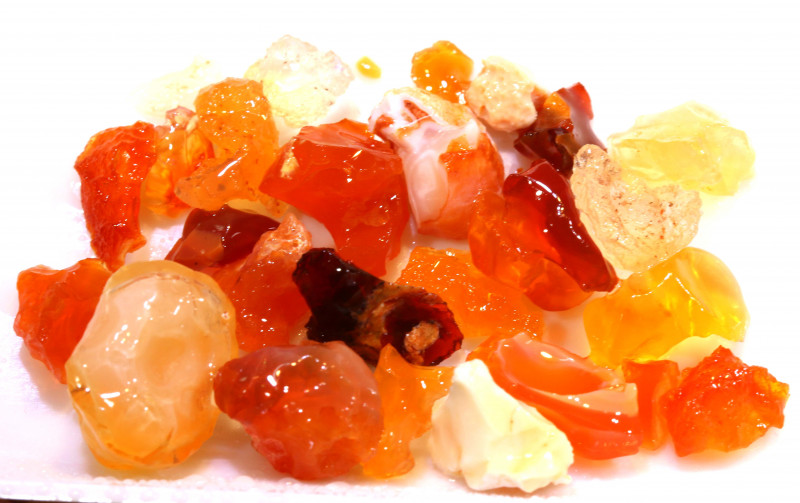
Central & South American Opal
Mexican Opal: Mostly known for fire opals, but Mexico also produces madera opals, contra luz opals, cantera boulder opals, and some of the world’s best water opals.
Brazilian Opal: Known for crystal opal with pastel color flashes and low moisture content.
Peruvian Opal: Known for blue or pink Peruvian opal, which is also the country’s national stone.
Honduran Opal: Recognized for holding the world’s oldest opal mines and producing unique boulder and matrix opals.
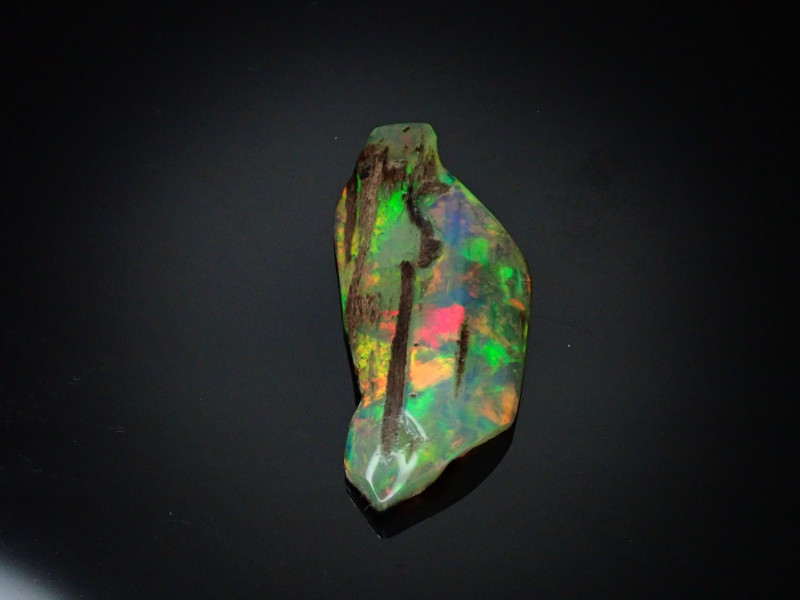
Other Locations
Indonesian Opals: Known for natural opalite and opalized wood.
American Opals: Mostly from Idaho, Utah, and Virgin Valley, notable American varieties include Owyhee opals, “Thunderegg” opals, rainbow opals, dendritic opals, opalized wood, hyalite, banded opals, Louisiana sand opals, and Utah bacon opals.
Slovakian (or Hungarian) Opals: Distinct white precious opals with internal blue and orange color flashes.
Other Opal Types
Some opals don’t fall neatly into a category, but they shouldn’t be overlooked!

Opalized Fossils
Like Jello molds, silica solution fills fossil imprints left in rocks and hardens into an opalized fossil! These opals can form in fossils of animal skulls, shells, pineapples, and even 100-million-year-old squid called opalized belemnite. While mostly found in Australia, miners have found opalized fossils in the USA, Hungary, and Indonesia.
What’s the most expensive opal? Believe it or not, an opalized fossil! The Virgin Rainbow is known as one of, if not the most expensive opal in the world at over $1 million. It’s actually an opalized fossil of an extinct cephalopod named belemnitida.
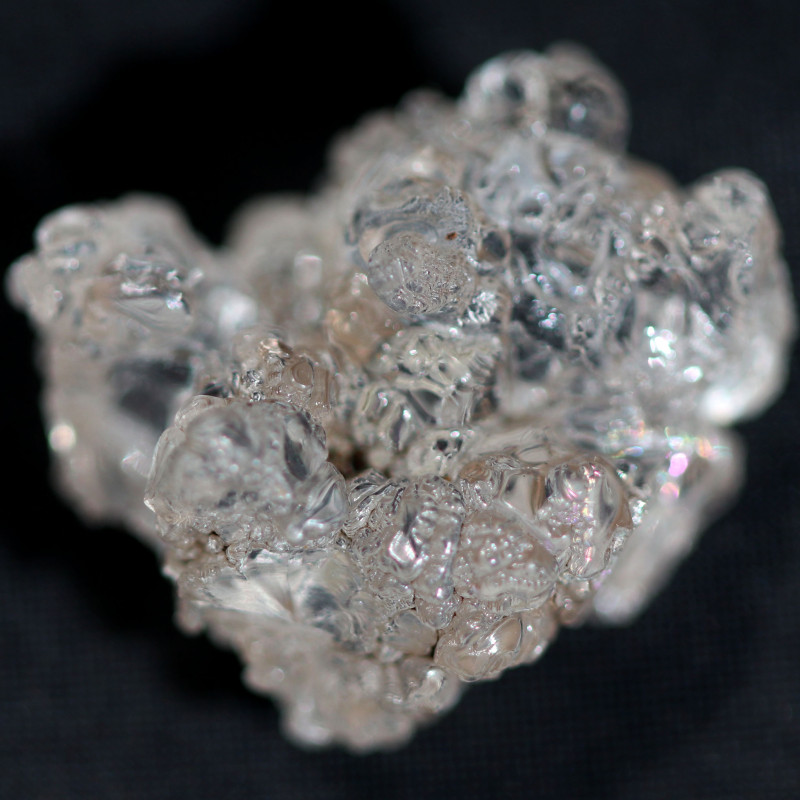
Hyalite
Hyalite is a unique type of opal called opal-AN, an amorphous opal with a network-like structure similar to glass. This colorless, pale yellow or green common opal variety doesn’t have silica spheres and won’t display play-of-color unless it has inclusions.
Hyalite’s most distinguishing feature is green fluorescence caused by its uranium content. The strong glow appears in UV light or direct sunlight.
Synthetic Opals
The words “synthetic,” “simulant,” and “imitation,” can confuse buyers. They all refer to man-made opals, but simulant opals have the same chemical composition as natural opals, while imitation opals only share a similar appearance.
In gemological terms, “synthetic” strictly refers to simulant opals. One exception is synthetic opalite, a man-made, opalescent glass resin.
The most common synthetic opals manufactured are black or white opals, but various simulant and imitation varieties have emerged:
Sterling Opal (Monarch Opal): Synthetic opal introduced in 2016 with various colors and black, linear patterns resembling potch inclusions.
Aurora Opal: Partly synthetic opal composed of silica and resin, available in seven body colors and displaying one-of-a-kind swirling patterns.
Dragon’s Breath Opal: Imitation opal with opalescence but no play-of-color, composed of Czechoslovakian glass and appears ruby-red but shifts into blue and purple hues when turned.

Which Opal Is Your Type?
And that covers every item on this complete list of opal types! Now that you know all the opal types and meanings, what’s your favorite? If you can’t decide, explore the hundreds of opal varieties available and find the right one for you!
Discover your favorite type of opal today!
Search the Opal Encyclopedia
Related Auctions
Related Articles
Australian Black Opal is one of the rarest gemstones on earth. It has every color of the rainbow on a black ground which makes the colors dance.
8th May 2018
Boulder Opal is one of the most undervalue opals valuable on the market. Learn more about this unique opal and browse the beautifully stones we have for sale.
29th May 2019
Latest Articles
An opal’s price comes down to a variety of factors, all of which we’ve broken down in this guide to opal grading and prices. Learn all about opal grading and the prices of each type of opal!
19th Jul 2023
Come on a journey and learn about the healing power of opals from our guest writer Vivien Schapera from Crystal Healing Techniques!
20th May 2023
The Flame (or Fire) Queen opal is the world’s most expensive opal, sold for the modern equivalent of $3 million dollars. Learn all about its history and qualities!
18th Feb 2023
Article Categories
All there is to know about Opals including Black Opals, Ethiopian Opals & Boulder Opal
15 Articles
Check out our fascinating information and articles on all things amazing in the Opal world
43 Articles
Opal Auctions sellers who are approved as opal Verified Sellers
4 Articles








